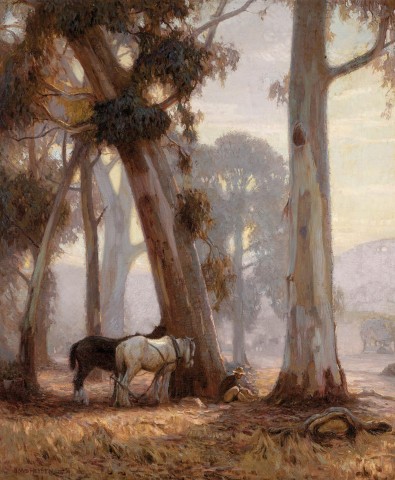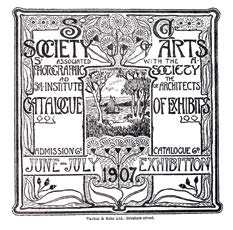A SUMMER’S DAY, c.1907
HANS HEYSEN
oil on canvas
90.0 x 74.5 cm
signed lower left: HANS HEYSEN
Private collection, Adelaide
Thence by descent
Private collection, Sydney
Annual Exhibition, South Australian Society of Arts, Adelaide, 13 June-6 July 1907, cat. 62, (illus. in exhibition catalogue p.6)
The 28th Annual Exhibition, Royal Art Society of N.S.W., Sydney, August, 1907
‘The Society of Arts. Annual Exhibition. An Admirable Collection’, Advertiser, Adelaide, 12 June 1907, p.8
‘Royal Art Society. The Annual Exhibition’, Evening News, Sydney, 24 August 1907, p.8
‘Royal Art Society. The 28th Exhibition’, Australian Town and Country Journal, Sydney, 28 August 1907, p.43
‘Royal Art Society’, The Lone Hand, Sydney, 1 October 1907, pp. 596-7
When exhibited in Sydney in 1908, Hans Heysen’s recently rediscovered oil painting, A Summer’s Day, c.1907 was acclaimed as ‘the landscape of the year’.1 One of the Australian master’s previously unknown major early works, it was painted shortly before his spectacular successes of 1908 and the years following. The highlight of the 28th Annual Exhibition of the Royal Art Society of New South Wales, A Summer’s Day was lauded in The Lone Hand by illustration and by word:
‘Mr. Hans Heysen, who sends many beautiful things from Adelaide, has a strong vein of natural poetry. He sees nature beatifically, and the commonest things take on a charm rendered through the eye of his vision… Mr. Heysen has painted the landscape of the year in his “Summer’s Day.” Cast against the light, the big blue-gums rise transparently against the smoky day, enveloped in a haze of heat suffocating and still. In their shadows doze the plough horses, the white one catching a sickly gleam of light. Blinded by the haze, the range fades palpably away; the poor earth seems athirst for rain or the coolness of night, tortured by the cruel glory of the sun. And all this is conveyed by the sheer truth of the painter’s vision, by his careful observation, without agitation, without dramatic accessory.’2
Previously, when A Summer’s Day was exhibited in Adelaide in the annual exhibition of the South Australian Society of Arts in 1907, it was received with like acclaim. Handsomely illustrated full page in the catalogue, it also featured in The Adelaide Chronicle.3
Adopting a favourite Heysen theme of the well-earned rest after a day’s hard toil, A Summer’s Day provides an early, engaging example of man and beast resting in the shade of noble gums, here in the company of horses, later with cattle or sheep. Companion variations are found in A Lord of the Bush, 1908, bought that year from Heysen’s first Melbourne solo exhibition by the National Gallery of Victoria; and The Three Gums, 1914-21, which slipped through the hands of the same state gallery into the welcoming arms of the Art Gallery of Ballarat. In 1909, the watercolour Summer, in the collection of the Art Gallery of New South Wales, was awarded the Wynne Prize for the most outstanding landscape painting of the year. A Summer’s Day enjoys this prestigious company, described by an admiring contemporary as ‘the most beautiful Australian landscape [Heysen] has painted, and the most typical.’4
1. ‘Royal Art Society’, The Lone Hand, Sydney, 1 October 1907, p.596
2. Ibid, pp.596-7.
3. ‘South Australian Society of Artists: Some of the Pictures,’ Adelaide Chronicle, 29 June 1907, p.30.
4. Australian Town and Country Journal, Sydney, 28 August 1907, p.43.
DAVID THOMAS

